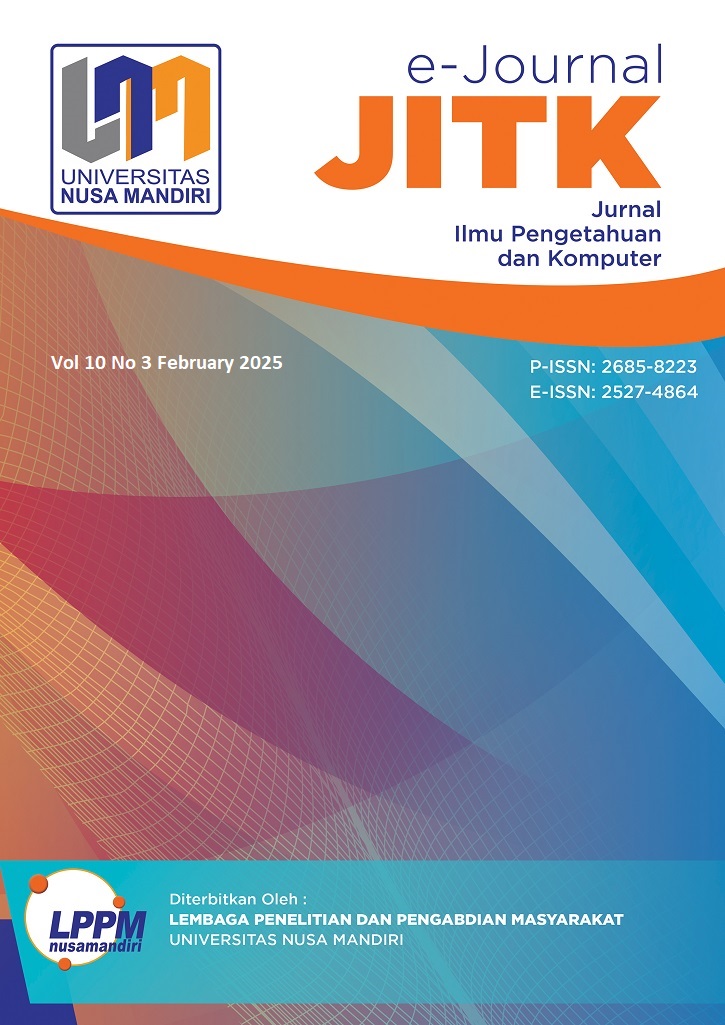APPLYING K-MEANS CLUSTERING FOR GROUPING PAPUA’S DISTRICTS BASED ON POVERTY INDICATORS ANALYSIS
DOI:
https://doi.org/10.33480/jitk.v10i3.5865Keywords:
elbow method, k-means clustering, papua, poverty indicators, silhouette methodAbstract
In the context of Indonesia's resource-rich development, poverty remains a major challenge, especially in Papua Province which has the highest poverty rate. Although Papua is rich in resources such as minerals, tropical forests, and biodiversity, challenges such as economic inequality, lack of infrastructure, and social conflict hinder economic and social progress. This research aims to implement the K-Means Clustering algorithm to cluster districts/cities in Papua based on poverty indicators, including the percentage of poor people, poverty line, average years of schooling, human development index, poverty depth index, poverty severity index, unemployment rate, and per capita expenditure. The research methodology includes data collection from the Central Statistical Agency (BPS), data processing through cleaning and transformation stages, and application of K-Means Clustering to determine the optimal cluster using the elbow method and silhouette score. The results show that the districts/cities in Papua can be grouped into two main clusters: C0, which indicates high poverty rates and C1, which indicates low poverty rates. This research is expected to provide a strategic foundation for the government to design more focused and effective development policies in reducing poverty in Papua.
Downloads
References
L. S. Hasibuan, P. Hariani, and A. S. Pratiwi, "Poverty development post fiscal decentralization policy in Otsus fund receiving province in Indonesia (Case study: Province of Papua, West Papua, and Aceh)," International Journal of Economic, Technology and Social Sciences (Injects), vol. 2, no. 2, pp. 562-574, 2021. DOI: https://doi.org/10.53695/injects.v2i2.598
A. Bahauddin, A. Fatmawati, and F. P. Sari, "Analisis Clustering Provinsi Di Indonesia Berdasarkan Tingkat Kemiskinan Menggunakan Algoritma K-Means," Jurnal Manajemen Informatika Dan Sistem Informasi, vol. 4, no. 1, pp. 1-8, 2021. DOI: https://doi.org/10.36595/misi.v4i1.216
E. Andriaswati and S. Utami, "Determinants of poverty rates in Papua province in 2011-2019," Efficient: Indonesian Journal of Development Economics, vol. 5, no. 1, pp. 1453-1467, 2022. DOI: https://doi.org/10.15294/efficient.v5i1.50928
A. W. F. Amin, "The Dynamic of Education Outcome in Decentralized Indonesia," Indonesia at The Crossroads: Transformation and Challenges, p. 149, 2023.
F. B. Putra, A. T. R. Dani, and S. Wigantono, "Penerapan Algoritma Hierarchical Clustering Dalam Pengelompokkan Kabupaten/Kota Di Papua Berdasarkan Indikator Kemiskinan," MAp (Mathematics and Applications) Journal, vol. 5, no. 2, pp. 118-126, 2023. DOI: https://doi.org/10.15548/map.v5i2.7025
N. Rahmadani, E. Rahayu, and A. Lestari, "K-Means Clustering Areas Prone To Traffic Accidents in Asahan Regency," JITK (Jurnal Ilmu Pengetahuan dan Teknologi Komputer), vol. 6, no. 2, pp. 181-186, 2021.DOI: https://doi.org/10.33480/jitk.v6i2.1519
I. Agustina and R. D. Dana, "Implementasi K-Means Clustering Untuk Pengelompokan Tingkat Kemiskinan Di Pulau Jawa Menggunakan Bahasa Pemrograman Python," JATI (Jurnal Mahasiswa Teknik Informatika), vol. 8, no. 1, pp. 945-951, 2024. DOI: https://doi.org/10.36040/jati.v8i1.8858
M. Matdoan, L. Igo, R. Rumeon, R. Fadhilah, and N. Laamena, "Penerapan Algoritma K-Means Untuk Klusterisasi Kabupaten/Kota Berdasarkan Tingkat Kemiskinan di Kepulauan Maluku dan Papua," Jurnal Sains Matematika dan Statistika, vol. 10, no. 1, pp. 1-9. DOI: http://dx.doi.org/10.24014/jsms.v10i1.21260
A. Khalif, A. N. Hasanah, M. H. Ridwan, and B. N. Sari, "Klasterisasi Tingkat Kemiskinan di Indonesia menggunakan Algoritma K-Means," Generation Journal, vol. 8, no. 1, pp. 54-62, 2024. DOI: https://doi.org/10.29407/gj.v8i1.21470
A. Sani, A. Andrianingsih, S. Aisyah, and A. Taufik, "Dampak Kesiapan Organisasi terhadap Keberhasilan Cloud Computing di UMKM dengan Model Delone Dan Mclean," Infotech: Journal of Technology Information, vol. 10, no. 2, pp. 319-326, 2024. DOI: https://doi.org/10.37365/jti.v10i2.325
E. Muningsih, I. Maryani, and V. R. Handayani, "Penerapan Metode K-Means dan Optimasi Jumlah Cluster dengan Index Davies Bouldin untuk Clustering Propinsi Berdasarkan Potensi Desa," Evolusi: Jurnal Sains dan Manajemen, vol. 9, no. 1, 2021. DOI: https://doi.org/10.31294/evolusi.v9i1.10428
R. Buaton and S. Solikhun, "A Comparative Evaluating Numerical Measure Variations in K-Medoids Clustering for Effective Data Grouping," JITK (Jurnal Ilmu Pengetahuan dan Teknologi Komputer), vol. 10, no. 2, pp. 394-403, 2024. DOI: https://doi.org/10.33480/jitk.v10i2.5545
C. Shi, B. Wei, S. Wei, W. Wang, H. Liu, and J. Liu, "A quantitative discriminant method of elbow point for the optimal number of clusters in clustering algorithm," EURASIP journal on wireless communications and networking, vol. 2021, pp. 1-16, 2021. DOI: https://doi.org/10.1186/s13638-021-01910-w
B. Ratner, B. Ratner, Ed. Statistical and Machine Learning. Techniques for Better Predictive Modelling and Analysis of Big Data. U.S.A: Taylor & Francis Group, 2017, p. 655.
P. Naik, G. Naik, and M. Patil, "Conceptualizing Python in Google COLAB," India: Shashwat Publication, 2022.
S. Saraswat, V. Agrohi, M. Kumar, M. Lamba, and R. Kaur, "Unveiling Consumer Segmentation: Harnessing K-means Clustering Using Elbow and Silhouette for Precise Targeting," in International Conference on Computing and Communication Networks, 2023, pp. 355-369: Springer. DOI: https://doi.org/10.1007/978-981-97-0892-5_28
A. Punhani, N. Faujdar, K. K. Mishra, and M. Subramanian, "Binning-based silhouette approach to find the optimal cluster using K-means," IEEE Access, vol. 10, pp. 115025-115032, 2022. DOI: https://doi.org/10.1109/ACCESS.2022.3215568
M. Khorasani, M. Abdou, and J. H. Fernández, Web application development with streamlit: Develop and deploy secure and scalable web applications to the cloud using a pure Python framework. Springer, 2022. DOI: https://doi.org/10.53695/injects.v2i2.598
P. Lemenkova, "Processing oceanographic data by Python libraries NumPy, SciPy and Pandas," Aquatic Research, vol. 2, no. 2, pp. 73-91, 2019. DOI: https://doi.org/10.3153/AR19009
A. Testas, "Support Vector Machine Classification with Pandas, Scikit-Learn, and PySpark," in Distributed Machine Learning with PySpark: Migrating Effortlessly from Pandas and Scikit-Learn: Springer, 2023, pp. 259-280. DOI : https://doi.org/10.1007/978-1-4842-9751-3_10
Downloads
Published
How to Cite
Issue
Section
License
Copyright (c) 2025 Yusriana Chusna Fadilah, Asrul Sani, Andrianingsih Andrianingsih

This work is licensed under a Creative Commons Attribution-NonCommercial 4.0 International License.











-a.jpg)
-b.jpg)














